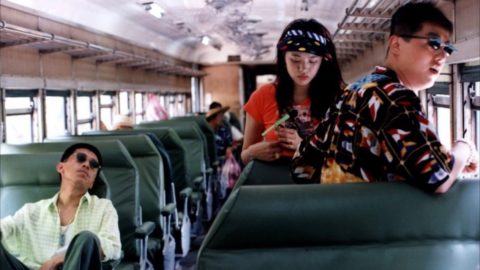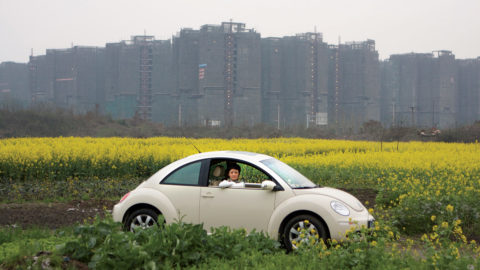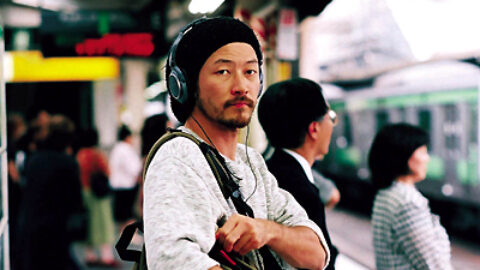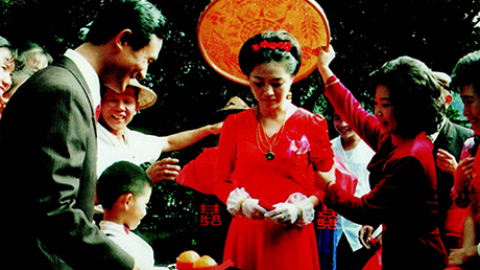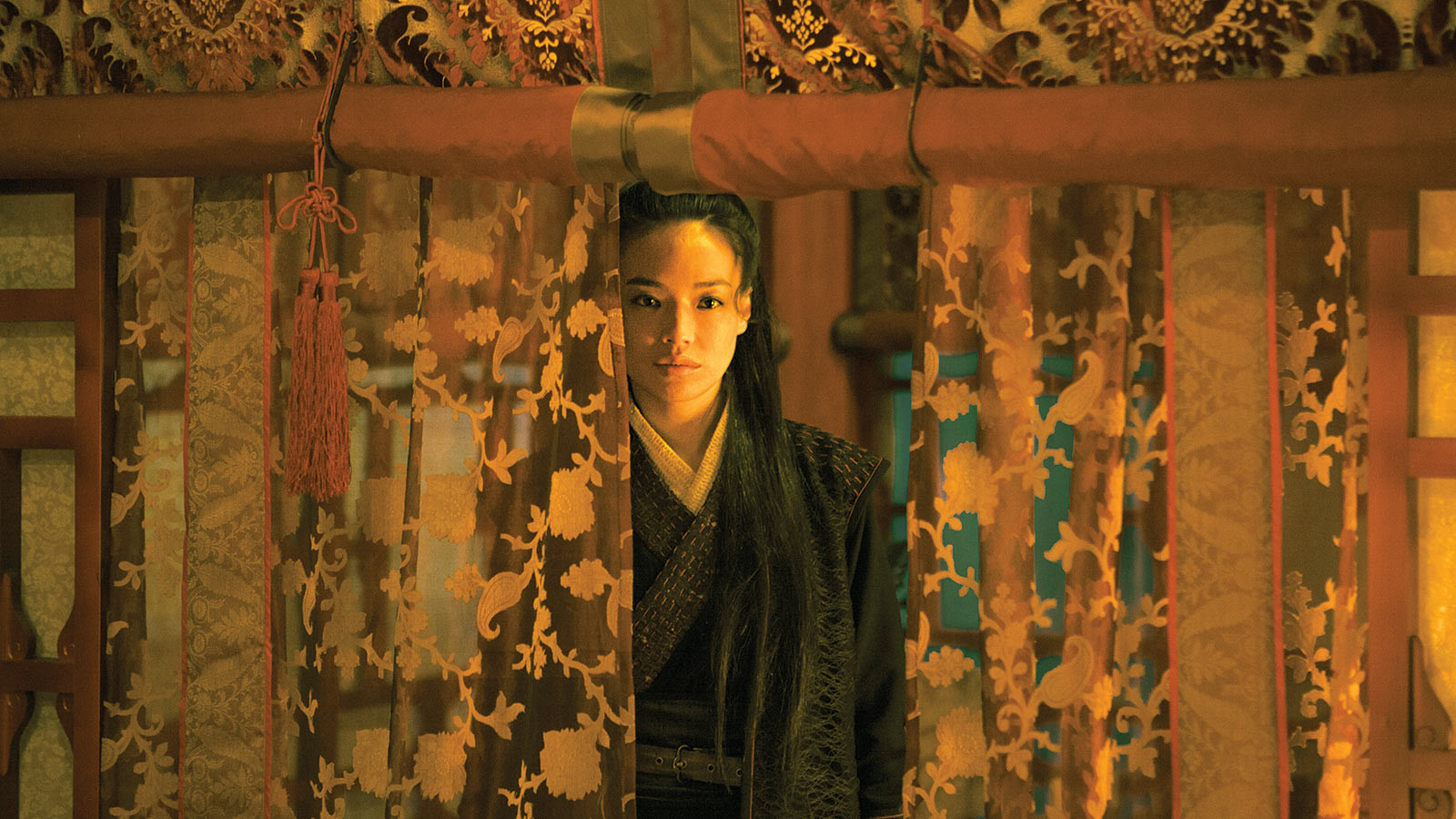
Killer Technique
Films need people more than stories.
Landscapes also harbor emotions.
Music can blow like the wind through a scene.
—Hirokazu Kore-eda, Things I Learned from Hou
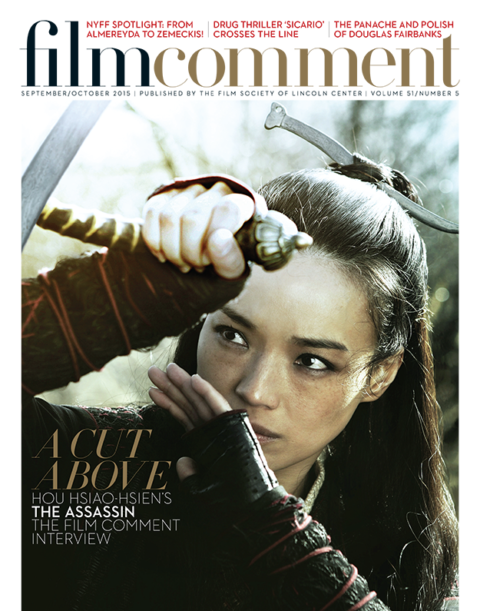
An unparalleled reservoir of cultural memory, the wuxia genre has deep roots in ancient Chinese history. Fueled by fanciful imagery of Heaven and Hell, these stories about legendary assassins who once roamed the country unfold against the backdrop of China’s vastly shifting political climes, bearing an otherworldliness anchored in a certain social realism. Ever pervasive in poetry, novellas, and serials, they have stirred the imagination of filmmakers for as long as the medium has existed in China. The wuxia film—combining elements of music, dance, literature, and martial arts—is a total art form that belongs wholly to Chinese tradition. By now it’s almost a rite of passage for a major filmmaker from Hong Kong, Taiwan, or Mainland China to make one, from Wong Kar Wai to Jia Zhang-ke.
Once praised by Jia as “the genius narrator passing down the memories of a nation through films,” Hou Hsiao-hsien, at age 68, has made his first wuxia film. Its long and arduous production (adhering to a $15 million budget) began shortly after Flight of the Red Balloon was released in 2008, leaving the longest gap in the Taiwanese filmmaker’s career since his first feature in 1980. Because it had originally been scheduled to be completed last year and timed to an international touring retrospective, the anticipation for its Cannes premiere was all the more ardent.
Adapted from the Tang Dynasty short story “Nie Yinniang,” The Assassin is about a princess (Shu Qi, in a piercing performance) who was abducted from her Imperial family by a nun in exile and trained to become a vigilante killer for the sole purpose of murdering corrupt politicians. As punishment for failing one of her assignments, the nun (Zhou Yun) sends her home to kill her beloved cousin (Chang Chen, who starred opposite Shu Qi in 2005’s Three Times), now a prominent military leader.
Scenes of breathtaking, expansive, and meditative stillness alternate with swift, cutting sword-fighting action. With his uncanny visual and aural ability to draw the past into the present, Hou instills scenes set in the 9th century with a haunted realism. Whereas the opiate-tinged beauty of the Qing Dynasty pleasure quarters in The Flowers of Shanghai (98) was tempered by formal strictures, here Hou lets cinematographer Mark Lee Ping Bin’s indelible long takes linger and steep us in the Imperial grandeur and sublime imagery. His third film to reckon with Chinese history (The Puppetmaster was the first film he shot in Mainland China), The Assassin is also his most monumental in scale and breadth, and a poised distillation of his aesthetic codes. Delving into themes of captivity and freedom, Hou finds a parallel between his own contrasting visual strategies—defined by rigorous formal planning and on-set improvisation—and the plight of these characters trapped between their piety and unrequited emotional desires.

The Assassin
Can you talk about the history of the wuxia genre?
The wu in wuxia means both “to cut” and “to stop.” It also refers to the weapon—usually a sword—carried by the assassin, the hero of the story. The genre became very popular during the Song Dynasty [960–1279]. These stories often depicted a soldier in revolt, usually against a corrupt political leader. In order to stop corruption and the killing of innocent people, the hero must become an assassin. So wuxia stories are concerned with the premise of ending violence with violence. Although their actions are motivated by political reasons, the hero’s journey is epic and transformative—physically, emotionally, and spiritually. In the Tang Dynasty, a prominent poet named Li Bai wrote some verses about an assassin. This is the earliest example I know of wuxia literature. Gradually, the genre gave shape to ideas and stories that had been percolating in historical and mythological spheres. Although these stories were often inspired by real events of the past, to me they feel very contemporary and relevant.
It’s one of the oldest genres in Chinese literature, and there are countless wuxia novels today. I began to immerse myself in these novels when I was in elementary school, and they quickly became my favorite things to read. I started with newer books and worked my way back to the earliest writing from the Tang Dynasty.
When did you first encounter wuxia films?
They were among the many films I watched by sneaking into movie theaters as a kid. I would tug on the sleeves of the grown-ups in line and ask them to take me inside. In middle school, I often went to the cinema with a friend. We would go to the first screening of that day, and after, when the lights came on, we would look for ticket stubs that had fallen between the seats on the floor. Then, we would go to the ticket-taker booth and steal the other half of the stubs that have been torn off. We glued the two parts together to make a complete ticket.
Back then, there were only four theaters in my hometown of Fengshan. Three would show film, and one was an opera house. I became obsessed with movies there. Every time a new film was on screen, I would go see it. This hobby carried over when I left for Taipei to go to film school. After school, I was a computer salesman for about one year. Those huge machines were very pricey back then! After that, I sought film-related work, and eventually entered the industry as a writer and assistant director. In all these decades, I never stopped reading wuxia novels.
When did you decide to adapt Pei Xing’s “Nie Yinniang” story?
In university, I was reading a lot of Tang Dynasty literature. The chuanqi—which “Nie Yinniang” was written as—was a popular short-story form from that period, and there are many female characters in these stories. I read this chuanqi in freshman year, and I loved the idea of a princess turned female assassin. I always kept this book in my memory, and thought about adapting it ever since I entered the industry working as a writer and assistant director.
So you have been waiting to make a wuxia film for a long time.
From very early on in my career, it has been my intention, but there is a process to everything. In the beginning, I couldn’t afford not to pay attention to things like box-office earnings. I had to appease the market, prove my abilities as a filmmaker, and earn people’s trust so they could invest in my future films. What everyone wanted me to make back then were comedies, so that’s what I made. They were highly marketable and sold very well. After proving myself, I earned a position that allowed me to make personal films about my own past experiences: my childhood and how I grew up. I was acutely aware of the wuxia film as being the one missing piece of the puzzle, because the memories of those novels from my childhood have lived inside me for all these years.
The reason for this long delay is very clear: it is the most difficult kind of film to make. It is epic on the level of choreography, mise en scène, and movement. You need to set everything perfectly into place before you start, and that requires a lot of preparation and planning. In recent years, I started thinking to myself that if I don’t make this soon, I’ll keep getting older. The people I work with will get older. So I made the decision to finally adapt one of the wuxia novels that captivated my young imagination—to resurrect the Tang Dynasty and the heroine who stirred my imagination. But it wasn’t easy. The historical and cultural background of the Tang Dynasty is very complex, which is why traditionally a lot of filmmakers stayed away from portraying this period. A lot of work needed to go into the design to reach a level of authenticity, from the sets to the costumes, down to the smallest details. It took us years to prepare.
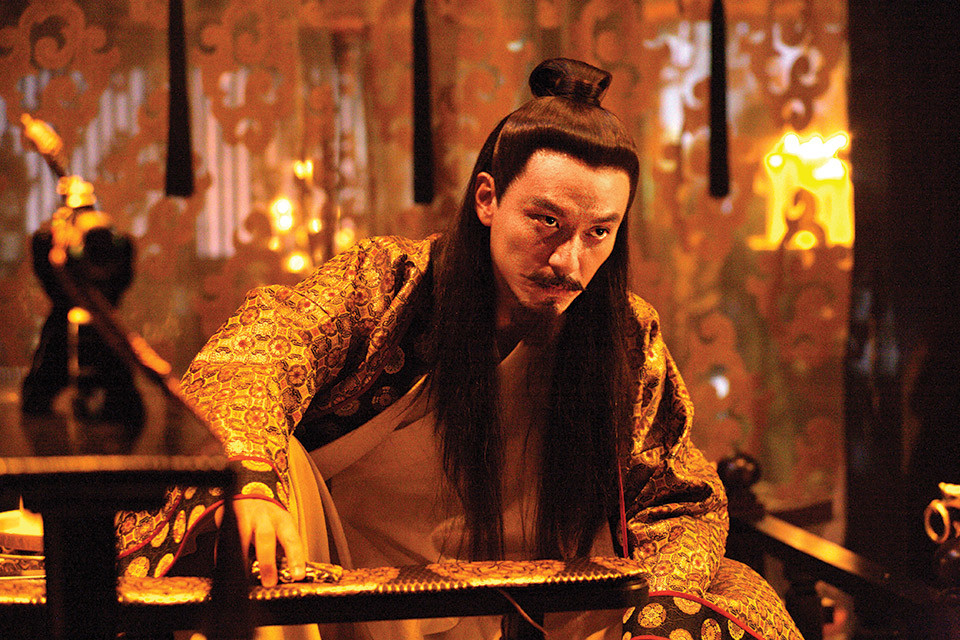
The Assassin
I heard you were going to use a Bolex camera. Why did you finally decide against it?
My cinematographer Mark Lee Ping Bin and I did some tests with the Bolex before principal photography in Japan. Although he is a few years younger than me, Lee is not a young man anymore, and he had a difficult time looking through the view-finder of this camera and getting precisely the right shot. One of Lee’s assistants, who has been with my company for many years, knew how to use one, but I thought one camera wasn’t enough. I wanted to shoot with three cameras on the actors at all times. It was difficult to find anyone else who knew how to use it, so we had the scrap the idea. We decided to go with a regular 35mm film camera. In the end, I shot nearly 500,000 feet of 35mm film!
What would it have been like if you had used a Bolex, and made the film in 16mm?
I specifically wanted to use a wind-up. You wind the camera up, and shoot for less than one minute, and you have to wind it up again. I like the inscribed structure of this filming process and the inherent limitation it posed. I always want to set some kind of external limit for myself before working. They become a very important part of my process and the structuring principle of each film. Flowers of Shanghai, for example, was made with only 30 shots. I believe that imposing such limits forces an artist to be more creative. Complicating the terms of the filmmaking process with these structures can lead to interesting surprises beyond what I could have imagined on my own.
How does this artistic tenet relate to the Nie Yinniang character?
An externally imposed set of limits also defines her freedom. Yet it’s those limits that bring forth her unrequited emotions and her destiny. As with her life—and with filmmaking—you need to know your limit before you can know where you’re going. Without this structure, you may have absolute freedom, but have no direction. Without direction, your imagination can’t be activated. Once you know the perimeter that defines your reality, you would no longer waste time contemplating where those limits lie, because they become part of your concrete reality. Only then can you know your true freedom.
Can you talk about how the script came together, and your collaboration with the three other writers?
Xie Hai Meng is an author I admire, and a Tang specialist. I got her together with Zhong Acheng and Chu Tien-Wen, and we had long conversations about the historical background for the film. Details from the Imperial court in this period were all very scrupulously recorded and passed down. We read them and looked for details that had dramatic qualities. It was most important to pin down the exact historical moment when this story could have happened. We needed to know this before thinking about the inner qualities of each character.
When did you know you were going to shoot in Mongolia and Hubei province?
As soon as we finished the script, I went to Hubei province. I found indelible landscapes there. We went to a village where the way the people live hasn’t changed very much from ancient times. They still reside in large agrarian families. In the nighttime they light fires and go to sleep with it burning next to their beds. I left these interiors virtually untouched during the filming process. The forests there were too small for the fight scenes, so we went to Inner Mongolia to shoot those outdoor scenes.
The Assassin
Were Shu Qi and Chang Chen involved from the beginning?
I had them in mind from the very beginning, even before I started writing the script. I’ve worked with Shu Qi on many films now. I can understand Shu Qi’s range of emotional states very well. I also understood very clearly how Chang Chen could inhabit his role. We see each other at film festivals often, and we always call each other over holidays. I always see them when I’m in Hong Kong. We’re very good friends, and I love collaborating with them.
What was the biggest challenge for the actors?
The biggest challenge was getting the right emotional tenor while speaking in this old language [guwen, or Classical Chinese]. The spoken language back then was different from the written language. It had a much smaller vocabulary, and did not communicate emotional subtleties easily. Language was more basic back then. Or you could say that each word carried much more meaning. The actors had to practice how to draw out the emotional nuances in their performances with their bodies and faces, because they couldn’t rely on the dialogue. That was the most difficult part. It’s not a big deal if they mess up the lines—we can always fix that in postproduction. The important thing is we get the shifting emotional qualities of each character.
You often set aside your scripts when you’re filming. Was this the case with The Assassin?
Although we worked on the script for a long time, when it came time to film, we were faced with the reality of the present moment. After we see all the actors in their costumes inhabiting the sets for the first time and how the natural light of the location affects the image, when the concept is met with concrete execution, certain adjustments are always needed. Once we were on location, I needed to make all kinds of recalibrations until I could convince myself this was a scene from the past—that it held the flavor of the Tang Dynasty, and felt it was okay to begin shooting. Aside from setting the atmosphere, some of the dramatic moments often needed to be revised, so the script would also change accordingly.
Did you stick with your no-rehearsal rule?
Indeed, no rehearsals. The only rehearsal we did was for the dance sequence, just to memorize the choreography. Everything else, including the fights, had to be spontaneous and unstudied. I want to feel like the actors are speaking to me directly, and I am filming them directly. If it doesn’t work, we try again. Sometimes, we wait a few days and try again. Sometimes we discarded the scene entirely. I can tell by looking in the eyes of my actors if they are not ready for a scene yet. This method also gives them a positive kind of pressure. If they know what they’re doing isn’t working, they can find another approach quickly because they learn to be impulsive.
How did you conceive of realism with this story from such a remote location and time?
Conceptualizing the realism of the Tang Dynasty first begins with the written word. I started by rereading all the books from my childhood, and reawakened their worlds in my mind. Books written during and about the Tang period, especially in the chuanqi form, often described scenes of daily life in great detail. People had their distinct castes: Imperial court workers, poets, doctors, and so on. I respond very intuitively to the written word. In each Chinese character, there is a world of connotations. For example, the old character for bed, ta, describes the various parts of the bed; its shape and functions are all represented in this single Chinese character. The word for dance, wu, describes the body, dressed in traditional clothing in motion. Sometimes, I couldn’t find the specific detail I was looking for in my research, but from these characters you can reverse-engineer a great deal of Chinese history.
I tried to close in on some key details of daily life, and then zoom out to a wider canvas. For example, I learned that at dawn and dusk, the sound of the beating of drums would fill the streets. According to Tang custom, 3,000 drumbeats would sound from the imperial quarters. Every li [the unit in which distance was measured at the time], there is another drum that starts to beat, until everyone knew it was time to get up. This signified the beginning of a day. When it got dark, the drums would beat 500 times. This meant curfew time, when people had to stay confined to within one li of their living quarters. You can learn all this by reading the wuxia novels carefully. Beneath all the mystical or fantastic elements, you will find traces of daily minutiae, which help you understand the limits that defined life back then—how each day was bookended.
I read one book about a fox spirit who takes on human form and falls in love with a man. The other women in the village become suspicious of her identity because she goes to the market to buy clothes, rather than making them herself. From that, I learned that all women used to sew their own clothes in those days. Through these different levels of understanding, a reality of this past can slowly present itself. All you need is a little extra imagination to complete the picture. Of course, no one living has seen the Tang Dynasty with their own eyes. Moreover, the paintings of that period were very minimalist. But the more I read about it and steeped myself in it, the more real this world became to me.
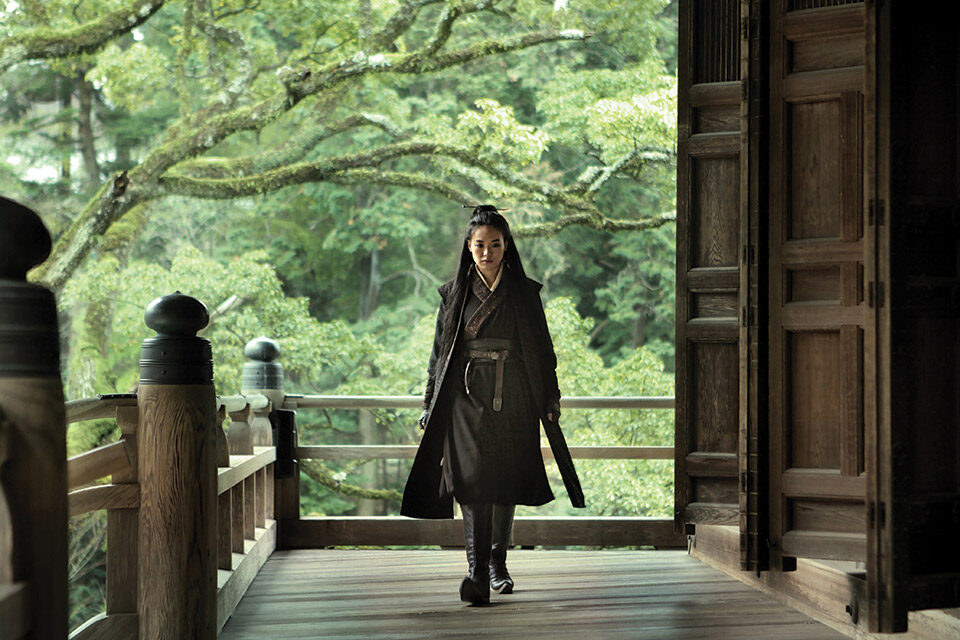
The Assassin
Can you explain the motif of the bluebird and the mirror in the story first told by Nie Yinniang’s master, and later recalled by Nie?
This imagery came from Tang Dynasty literature. It quickly became a widely used metaphor all over the country. In the original story, the bluebird is a peacock, an exotic pet kept by the King of Jibing. Wishing it would sing, the Queen and King decide to place a mirror in front of it, hoping it might think its reflection was a companion who had come to visit. When it saw its own image, it began to sing out all its sadness until death came the next morning. The mirror and the bluebird are interchangeable metaphors for the self, and the deepest sadness, and loneliness. It describes the emotional quality of someone living in solitude, like Nie Yinniang, who was taken to Weibo and lived in isolation, away from everyone she knew.
What kind of directions did you give to Lim Giong for the film’s percussive score?
I left the music completely up to Lim Giong. He always knows just what I’m looking for. He recorded the sounds of popular instruments used in Tang music and familiarized himself with their sonic qualities before composing the score. The drums in the first part of the film correspond to the dawn or dusk, as I just described.
It’s been eight years since your last film, Flight of the Red Balloon, came out. Can you comment on the vast changes that have taken place in the Asian film industry?
For three of these eight years, I was serving as the president of the Taipei Film Festival. For the last five years I have been the president of the Golden Horse Awards. I have been observing the shifting landscape of contemporary Asian cinema from these positions on the other side of filmmaking. I’ve seen a huge spike in the number of Mainland films being made year after year. Inversely, Hong Kong productions have slowed down considerably. It’s an undeniable fact that the Mainland film market is increasing in magnitude. Given the population there, and the new theaters being built, it’s not surprising. Sadly, the Taiwan market seems to be getting smaller. People are making fewer films here compared to eight years ago. In general, there is less local cinema being made compared to eight years ago. What is local film identity? Being able to really look at your environment, the people in it, and be inspired to condense all this into a script for a film that in turn reflects back on daily life. That’s what the Taiwanese New Wave represented. Of course, these types of films have always been rare around the world, and they have a small audience. They are outliers in the market. Now audiences in Mainland are viewing all kinds of films online. In this ever-changing climate, perhaps there will be a new wave.
You’ve talked about your dream of owning your own cinema. Have you realized this dream yet?
I have three art-house theaters in Taiwan. They’re called Spot cinemas, and I think they may be the only places that still project celluloid.
Will your next film be shot on 35mm, like The Assassin?
I’m pretty sure it will be digital, because it’s so expensive to shoot on film these days. If you use film, the footage needs to be scanned digitally, which takes a lot of time and money. I’m thinking to myself, maybe forget about film, and try going digital. I’ve been putting it off until now. With celluloid, other tests are required to find the tone, palette, texture of the exact image I need to create. With Goodbye South, Goodbye [96], I added red filters to accentuate the indigos and greens and blacks in Taiwan’s landscapes. We do this before shooting each film, including The Assassin, to find the right tone for the image. With The Assassin, all the “effects” were applied directly on the camera, and not in the postproduction process. In making this switch to digital, I’ll need to do a lot of tests. I’ll try a lot of different filters. I need to grasp the essence of this digital medium first—to find its limit. Only then will I be able to determine whether it works for me.



